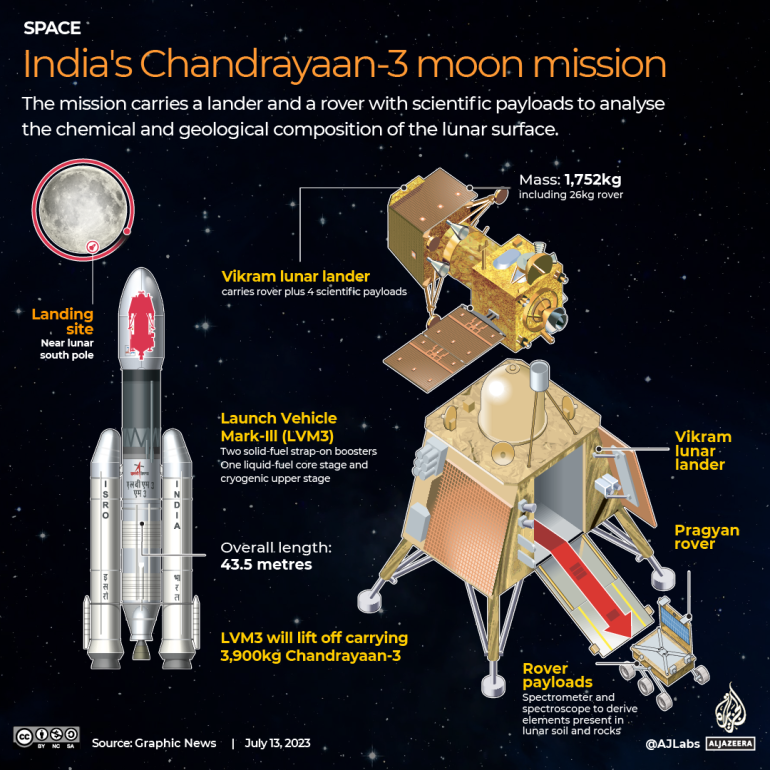Will India’s new moon mission propel it into an elite orbit?
India’s space agency is readying to launch a rocket as soon as Friday that will attempt to land a rover on the moon and mark the country’s arrival as a power in space exploration and the new frontier of space commerce.
Built on a budget of less than $75m, the Chandrayaan-3, which means “moon vehicle” in Sanskrit, is set to blast off from India’s main spaceport in the southern state of Andhra Pradesh at 2:35pm local time (09:05 GMT).
India’s bid for elite group
If the mission succeeds, India will join a small group of nations comprising the United States, the former Soviet Union and China that have made soft landings on the moon.
An attempt by a Japanese start-up earlier this year ended with the lander crashing due to an altitude miscalculation that meant the spacecraft ran out of fuel.
An Israeli spacecraft, built by SpaceIL and Israel Aerospace Industries (IAI), also crashed into the moon’s surface earlier this year.

What happened to Chandrayaan-2?
India’s space industry will be looking for redemption with this mission after the Chandrayaan-2 mission in 2020 successfully deployed an orbiter, but its lander and rover were destroyed in a crash.
The Chandrayaan-2 mission was designed to study permanently shadowed moon craters that are thought to contain water deposits confirmed by an earlier Chandrayaan-1 mission in 2008.

Where will Chandrayaan-3 land?
If everything goes to plan, the 43.5-metre (143-foot) Launch Vehicle Mark-III, or LVM3, rocket will blast the spacecraft into an elliptical Earth orbit before it loops towards the moon for a scheduled landing around August 23 near where the Chandrayaan-2 crashed.
The LVM-3 is a three-stage rocket with two solid-fuel boosters and a liquid-fuel core stage. The solid-fuel boosters provide the initial thrust before the liquid-fuel core stage ensures sustained thrust to propel the rocket into orbit.
The Chandrayaan-3 includes a 2-metre (6.5-foot) tall lander designed to deploy a rover near the lunar south pole where water ice has been detected.
The rover is expected to remain functional for two weeks running a series of experiments.
Is India a leading space power?
The launch by the Indian Space Research Organisation (ISRO) is the country’s first major mission since Prime Minister Narendra Modi’s government announced policies to spur investment in private space launches and related satellite-based businesses.
Since 2020, when India opened to private launches, the number of space start-ups has more than doubled.
India, in recent years, has cemented itself as a leading supplier of commercial space operations, including the launch of its first privately developed rocket, Vikram-S, in November 2022 as part of a mission named Prarambh, meaning the beginning.
The mission developed by Skyroot Aerospace included investors such as Singapore’s sovereign wealth fund GIC.
India wants its space companies to increase their share of the global launch market by fivefold within the next decade, officials have said, up from 2 percent by revenue in 2020.
India is experienced in launching smaller satellites and has been trying to corner this market, pitching itself as a satellite launch facility.
In October, the ISRO announced that its rocket had successfully put 36 internet satellites into orbit for the UK-based satellite company OneWeb.
Is the Indian space industry working with NASA?
In July, India became the 27th country to sign the Artemis Accords with the US.
The ambitious Artemis programme aims to, among other things, land the first astronauts on Mars and eventually on other planets.
NASA and ISRO have also agreed to launch a joint mission to the International Space Station (ISS) in 2024.
On a visit to the US last month, Modi and US President Joe Biden pledged to deepen collaboration in space.
Voyager Space, a Denver-based company with a NASA contract to develop the planned Starlab space station, said this week it had signed a memorandum of understanding with ISRO to use Indian rockets and would look for opportunities to collaborate with Indian space start-ups.
“India sees space as a strategic asset, and it aims to become one of the leading players in outer space,” said Carla Filotico, managing director at consultancy SpaceTec Partners. “This could be India’s opportunity to be one of the pioneers in this industry.”
What are India’s Mangalyaan missions?
The ISRO plans to launch its second interplanetary mission next year, the Mangalyaan-2, which will observe and study the surface of Mars.
Mangal means Mars in Sanskrit, while yaan means craft or vehicle.
The first Mangalyaan mission entered Mars orbit in 2014 and operated for seven and a half years.
The mission cost only $74m and made headlines for costing less than the Academy Award-winning film Gravity.
A third Mangalyaan mission is also planned, which will include a soft landing on Mars in 2030.



